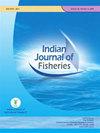养殖半岛鲤鱼幼苗放养密度的标准化 Barbodes carnaticus (Jerdon, 1849)
IF 0.3
4区 农林科学
Q4 FISHERIES
引用次数: 0
摘要
为确定 Barbodes carnaticus(Jerdon,1849 年)幼鱼的最佳放养密度,进行了为期 90 天的试验。鱼类在 24 平方米的水泥池中饲养,放养密度分别为 15、30、45、60、75、90、105 和 120 米-2。最初,在实验饲养池中施用牛粪,基础施肥量为 3 吨/公顷-1。施肥一周后,向饲养池中投放肉眼豚鱼苗(平均体长 0.98±0.04 厘米;体重 4.55±0.04 毫克)。在第一个月,按体重的 10%投喂花生油饼和米糠(1:1)的混合物。第二和第三个月,投喂以鱼粉为基础的沉性颗粒饲料(3 毫米,粗蛋白 35%)至饱。收获的鱼体重从 120 m-2 密度的 0.50 克到 15 m-2 密度的 3.53 克不等,鱼长从 120 m-2 密度的 3.55 厘米到 15 m-2 密度的 6.66 厘米不等。结果表明,放养密度与鱼体最终长度和重量成反比。条件因子在 1.01 至 1.20 之间,成活率在 85.66 至 91.47% 之间,各处理之间无差异(p>0.05)。放养密度为30 m-2和45 m-2时,每缸鱼的生物量最高,表明45 m-2是肉鲤鱼苗至鱼苗培育的最佳放养密度。关键词:鲤鱼 苗种饲养 物种多样化本文章由计算机程序翻译,如有差异,请以英文原文为准。
Standardisation of stocking density for raising fingerlings of farm-bred peninsular carp Barbodes carnaticus (Jerdon, 1849)
A 90-day trial was conducted to determine the optimal stocking density for raising fingerlingsof Barbodes carnaticus (Jerdon, 1849). The fish were reared in cement tanks of 24 m2 atstocking densities of 15, 30, 45, 60, 75, 90, 105 and 120 m-2. Initially, cow dung was appliedat a basal rate of 3 t ha-1 in the experimental rearing tanks. After a week of manuring, thetanks were stocked with fry of B. carnaticus (mean length 0.98±0.04 cm; weight 4.55±0.04mg). During the first month, the fish were fed a mixture of groundnut oil cake and rice bran(1:1) at 10% of body weight. A sinking pellet feed (3 mm, 35% crude protein) based on fishmealwas fed to satiation in the second and third months. The harvested fish weight ranged from0.50 g in 120 m-2 to 3.53 g in 15 m-2 densities, whereas fish length varied from 3.55 cm in 120m-2 to 6.66 cm in 15 m-2 densities. The results showed that the stocking density inverselycorrelated with final length and weight. The condition factor ranged between 1.01 and1.20, while survival rate varied from 85.66 to 91.47%, with no differences (p>0.05) betweentreatments. The highest fish biomass per tank was recorded under stocking densities of 30and 45 m-2, which indicates that 45 m-2 is the optimal stocking density for fry to fingerlingrearing of B. carnaticus. Keywords:Carnatic carp, Puntius carnaticus, Seed rearing,Species diversification
求助全文
通过发布文献求助,成功后即可免费获取论文全文。
去求助
来源期刊

Indian Journal of Fisheries
FISHERIES-
CiteScore
0.90
自引率
20.00%
发文量
0
审稿时长
6-12 weeks
期刊介绍:
Indian Journal of Fisheries is published quarterly by the Indian Council of Agricultural Research (ICAR), New Delhi. Original contributions in the field of Fish and fisheries science are considered for publication in the Journal. The material submitted must be unpublished and not under consideration for publication elsewhere.
Papers based on research which kills or damages any species, regarded as thratened/ endangered by IUCN crieteria or is as such listed in the Red Data Book appropriate to the geographic area concerned, will not be accepted by the Journal, unless the work has clear conservation objectives.
 求助内容:
求助内容: 应助结果提醒方式:
应助结果提醒方式:


